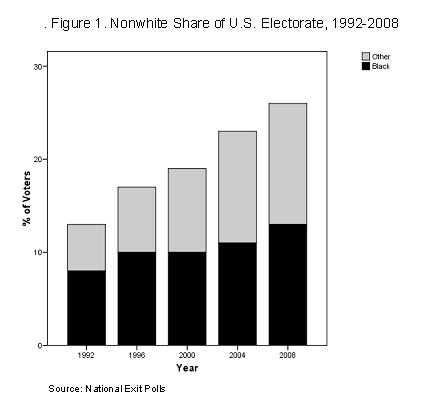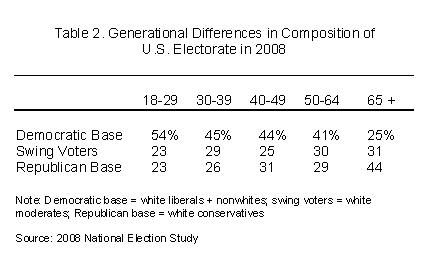Diverging Coalitions: The Transformation of the American Electorate
A Commentary By Alan Abramowitz
The election of America's first black president has been widely hailed as an historic event. However, much less attention has been paid to the demographic trends which made that event possible and which will continue to affect elections and politics in the United States far into the future. In this article I examine those trends and their consequences for the American party system.
Without question, the most important change in the composition of the American electorate over the past several decades has been a steady increase in the proportion of nonwhite voters. This trend has been evident for at least 50 years but it has accelerated in the last quarter century. It is a result of increased immigration from Asia, Africa and Latin America, higher birth rates among minority groups, and increased registration and turnout among African-Americans, Hispanics, and other nonwhite citizens. Moreover, this shift is almost certain to continue for the foreseeable future based on generational differences in the racial and ethnic composition of the current electorate and Census Bureau projections of the racial and ethnic makeup of the American population between now and 2050.
Figure 1 displays data from national exit polls on the changing racial composition of the U.S. electorate between 1992 and 2008. In the 16 years between 1976 and 1992, the nonwhite share of the U.S. electorate increased only slightly--going from 11 percent to 13 percent. However, in the 16 years between 1992 and 2008 the nonwhite share of the electorate doubled, going from 13 percent to 26 percent. Helped by an aggressive Democratic registration and get-out-the-vote campaign in African-American and Hispanic communities, the nonwhite share of the electorate increased from 23 percent in 2004 to 26 percent in 2008 with African-Americans going from 11 percent to 13 percent, and Hispanics going from 8 percent to 9 percent.
Since the 1970s the composition of the nonwhite electorate has itself been changing, with Hispanics (who are included here in the nonwhite population although they can be of any race) and Asian-Americans comprising a growing share of nonwhite voters. Both of these groups continue to be underrepresented in the electorate relative to their numbers in the voting-age population due to high rates of noncitizenship and relatively low registration and turnout rates. However, both groups are growing rapidly. Hispanics are now the largest minority group in the U.S. population and their share of the electorate has been rising steadily, reaching 8 percent in 2004 and 9 percent in 2008.
The growth of the nonwhite electorate, beginning with African-Americans in the 1960s and 1970s and continuing with Hispanics and Asian-Americans since the 1980s, has had profound consequences for the party system and the electoral process in the United States. Along with liberal whites, nonwhite voters constitute the electoral base of the modern Democratic Party while conservative whites constitute the electoral base of the modern Republican Party.
Although the loyalty of each party's base voters varies somewhat from election to election as a result of short-term factors such as the popularity of the presidential candidates and the state of the economy, each party can generally count on winning the overwhelming majority of votes from its own base. Moreover, evidence from national exit polls indicates that both parties' base voters have become more loyal over the past 32 years. In 1976, Jimmy Carter received only 74 percent of the vote from white liberals and nonwhites while in 1992 Bill Clinton received 81 percent and in 2008 Barack Obama received 85 percent. Similarly, in 1976, Gerald Ford received only 73 percent of the vote from white conservatives while in 1992 George H.W. Bush received 82 percent and in 2008 John McCain received 89 percent.
Moderate whites are the swing voters in presidential elections. They generally split their votes fairly evenly between the Democratic and Republican candidates, shifting slightly toward one side or the other depending on short-term factors. According to the 2008 national exit poll, Barack Obama received 53 percent of the vote among moderate whites. This was similar to the results for other newly elected Democratic presidents: Jimmy Carter received 49 percent of the vote of this group while Bill Clinton received 57 percent.
The data displayed in Table 1 show that over the last 32 years, and especially since 1992, there has been a fairly dramatic shift in the relative size of these three groups of voters. Largely as a result of the growth of the nonwhite electorate, the Democratic base has been expanding while the proportions of swing voters and Republicans have declined. The Democratic base has gone from the smallest of the three voter groups in 1976 to by far the largest in 2008. When Jimmy Carter was elected in 1976, moderate whites made up 45 percent of voters, conservative whites made up 30 percent, and liberal whites and nonwhites combined made up only 25 percent. Sixteen years later, when Bill Clinton was elected, these proportions had changed only slightly--moderate whites made up 43 percent of voters, conservative whites made up 27 percent, and liberal whites and nonwhites combined made up 30 percent. By 2008, however, the electorate looked very different--conservative whites still made up 27 percent of voters but moderate whites made up only 32 percent, and liberal whites and nonwhites combined made up 44 percent.
An examination of generational differences in the composition of the 2008 electorate indicates that the trends of the past 16 years are almost certain to continue for the foreseeable future. The fact that 18-29 year-old voters preferred Barack Obama to John McCain by a better than 2-to-1 margin in 2008 reflected more than Obama's personal appeal to younger voters. The data displayed in Table 2 show that voters under the age of 30 were by far the most Democratic age group based on their demographic characteristics and ideological orientations. Liberal whites and nonwhites combined made up 54 percent of this group while moderate whites made up 23 percent and conservative whites made up 23 percent. In contrast, voters aged 65 and over--the only age group that preferred John McCain to Barack Obama--were the most Republican age group based on their demographic characteristics and ideological orientations. Liberal whites and nonwhites combined made up only 25 percent of this group while moderate whites made up 31 percent and conservative whites made up 41 percent.
The changes in the make-up of the electorate have also had important consequences for the composition of each party's electoral coalition. Evidence from the American National Election Studies displayed in Table 3 shows that over time the Democratic electoral coalition has become less white and more liberal while the Republican electoral coalition has become less moderate and more conservative. Moderate-to-conservative whites made up 59 percent of Jimmy Carter's electoral coalition, but they made up only 33 percent of Barack Obama's electoral coalition. And conservative whites made up only 48 percent of Gerald Ford's electoral coalition but they made up 61 percent of John McCain's electoral coalition.
Conclusion
Barack Obama's victory in the 2008 presidential election was made possible by long-term changes in the composition of the American electorate, especially the growing voting power of African-Americans, Hispanics, and other nonwhites. As a result of these demographic changes, the Democratic Party enjoys a large advantage over the Republican Party in the size of its electoral base--an advantage that is almost certain to continue growing for the foreseeable future.
The Democratic and Republican electoral coalitions have been diverging over time with the Democratic coalition increasingly dominated by nonwhites and liberal whites and the Republican coalition increasingly dominated by conservative whites. As a result of these trends, Barack Obama's electoral coalition was quite different than the ones that elected earlier Democratic Presidents. Moderate-to-conservative whites made up a much smaller proportion of Obama's coalition than of either Jimmy Carter's coalition or Bill Clinton's coalition. At the same time, conservative whites made up a much larger proportion of John McCain's coalition than of either Gerald Ford's coalition or George H.W. Bush's coalition.
These trends in the composition of the parties' electoral coalitions have potentially important implications for governance as well as for elections. As the parties' coalitions have diverged, so have their ideological orientations and policy agendas. Growing polarization in Washington reflects growing polarization in the electorate (and vice versa). While President Obama cannot afford to ignore the views of moderate-to-conservative white voters, he can be expected to pursue a more liberal policy agenda than earlier Democratic presidents who were much more dependent on the support of moderate-to-conservative whites.
Dr. Alan Abramowitz is the Alben W. Barkely Professor of Political Science at Emory University, and the author of Voice of the People: Elections and Voting Behavior in the United States
See Other Commentary by Dr. Alan Abramowitz
Rasmussen Reports is a media company specializing in the collection, publication and distribution of public opinion information.
We conduct public opinion polls on a variety of topics to inform our audience on events in the news and other topics of interest. To ensure editorial control and independence, we pay for the polls ourselves and generate revenue through the sale of subscriptions, sponsorships, and advertising. Nightly polling on politics, business and lifestyle topics provides the content to update the Rasmussen Reports web site many times each day. If it's in the news, it's in our polls. Additionally, the data drives a daily update newsletter and various media outlets across the country.
Some information, including the Rasmussen Reports daily Presidential Tracking Poll and commentaries are available for free to the general public. Subscriptions are available for $4.95 a month or 34.95 a year that provide subscribers with exclusive access to more than 20 stories per week on upcoming elections, consumer confidence, and issues that affect us all. For those who are really into the numbers, Platinum Members can review demographic crosstabs and a full history of our data.
To learn more about our methodology, click here.







